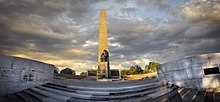National women's monument
The National Women's Monument ( English National Women's Monument or Afrikaans Nasionale Vrouemonument ) in Bloemfontein , South Africa , recalls the suffering of about 27,000 Boer women's and children in British concentration camps during the Second Boer War, died. Inaugurated on December 16, 1913, the monument is now a Provincial Heritage Site in the Free State province .
Building
The monument was designed by the architect Frans Soff , who came from Pretoria , and the sculptor Anton van Wouw . It consists of a 36.5-meter obelisk from Kroonstad - sandstone and low semicircular walls on both sides. A central bronze sculpture co-designed by Emily Hobhouse shows two grieving women and a dying child in the Springfontein concentration camp . The seated, barefoot woman, whose face expresses sadness, despair and horror, holds the dead child on her lap. The memorial is thus based on images of the grieving Mother of God , who holds the dead Jesus Christ , and stands in the traditions of Christian iconography of Anna selbdritt and the Pietà .
The memorial was unveiled on December 16, 1913 in the presence of about 20,000 South Africans. Thirteen years later, Emily Hobhouse's ashes were buried at the foot of the monument. Next to the monument are the graves of Christiaan de Wet , Rev. JD Kestell and the President of the Orange Free State Martinus Steyn and his wife.
origin
The idea for a memorial came from Martinus Steyn when he was receiving medical treatment in Europe after the Boer War. He was supported in his project by the British human rights activist Emily Hobhouse and the Afrikaans poet Totius . On his return to South Africa, Steyn put together a committee to get the project off the ground. The proposal to build a school or a hospital instead of the monument was rejected by several Boer organizations.
Boers raised £ 10,000 for the memorial from 1907 to 1911 . The start of construction was delayed by English-speaking Bloemfontein councilors who said the memorial cast a bad light on Britain and its local supporters of the war. Prime Minister Louis Botha , who pursued a policy of reconciliation between the warring parties after the war, also spoke out against the monument.
Intention and Effect

In addition to the Afrikaans campaign ( Tweede Afrikaanse Taalbewegung ), the campaign to finance the National Women's Monument contributed significantly to a new national consciousness among white South Africans and to the emergence of political nationalism. On the one hand, the monument was an expression of the Boer ideology of the “volksmoeder” (“mother of the people”), who assigned women to the household and child-rearing areas, but also transferred their motherhood to the nation as a whole. On the other hand, the memorial supported Boer nationalism, which was largely based on the construction of the passive suffering of Boer women in British concentration camps during the Boer War. The role of women in war was perceived and remembered selectively in a way that legitimized violence in defense of the vulnerable.
literature
- Albert Grundlingh: The National Women's Monument. The Making and Mutation of Meaning in Afrikaner Memory of the South African War . In: Gregor Cuthbertson, Albert M. Grundlingh u. Mary-Lynn Suttie (Ed.): Writing a Wider War. Rethinking Gender, Race, and Identity in the South African War, 1899-1902 . Ohio University Press, Athens, OH 2002, pp. 18-36, online ( October 24, 2003 memento on the Internet Archive ).
- Sabine Marschall: Serving Male Agendas. Two National Women's Monuments in South Africa . In: Women's Studies 33 (2004), pp. 1009-1033.
Web links
Individual evidence
- ^ A b The Women's Monument entry in the South African Heritage Resources Agency (SAHRA) Registry of Gazetted Sites, Objects and Shipwrecks . Archived from the original on March 3, 2012. Info: The archive link was inserted automatically and has not yet been checked. Please check the original and archive link according to the instructions and then remove this notice. Retrieved January 25, 2013.
- ↑ Description of the monument ( Memento of the original from March 3, 2012 in the Internet Archive ) Info: The archive link was inserted automatically and has not yet been checked. Please check the original and archive link according to the instructions and then remove this notice. (English), accessed November 3, 2014
- ^ Peter Warwick: The South African War. The Anglo-Boer War, 1899-1902 . Longman, London 1980, p. 396.
- ^ Elsabe Brink: Man-made women. Gender, class and the ideology of the volksmoeder . In: Cherryl Walker (Ed.): Women and Gender in Southern Africa to 1945. David Philip, Claremont 1990, pp. 278-280; Brandon Hamber et al. Ingrid Palmary: Gender, Memorialization, and Symbolic Representation . In: Ruth Rubio Marín (Ed.): The Gender of Reparations. Unsettling Sexual Hierarchies while Redressing Human Rights Violations. Cambridge UP, Cambridge 2009, pp. 337 f.
Coordinates: 29 ° 8 ′ 30 ″ S , 26 ° 12 ′ 30 ″ E





